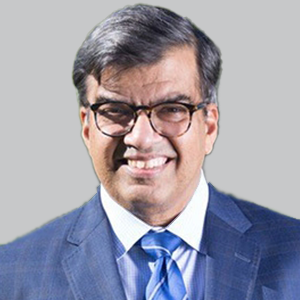Article
Post-Hoc Analysis of CHAMPION MG Study Highlights Ravulizumab’s Effects on Specific Muscle Domains
Author(s):
After previously showing positive effects on MG-ADL and QMG, ravulizumab continued to show improvements in ocular and respiratory muscle domains in myasthenia gravis.
Tahseen Mozaffar, MD, FAAN

Post-hoc data from the phase 3 CHAMPION MG study (NCT03920293) presented at the 2023 Muscular Dystrophy Association (MDA) Clinical and Scientific Conference, held March 19-22, in Dallas, Texas, showed that ravulizumab (Ultomiris; AstraZeneca), an FDA-approved therapy for myasthenia gravis (MG), significantly improves ocular and respiratory muscle domains.
Ravulizumab, a terminal compliment C5 inhibitor, was originally FDA-greenlit in April 2022 for adults who are anti-acetylcholine receptor (AChR) antibody positive based on data from CHAMPION MG. Led by Tahseen Mozaffar, MD, FAAN, director, UC Irvine-MDA ALS and Neuromuscular Center, director, Division of Neuromuscular Diseases, Neurology School of Medicine, the post-hoc analysis aimed to calculate least-square mean changes in Myasthenia Gravis Activities of Daily Living (MG-ADL), the primary end point, and Quantitative Myasthenia Gravis (QMG) total scores, in 4 separate muscle domains (ocular, bulbar, limb, and respiratory) as a percentage of the respective maximum domain scores.
In the double-blind trial, patients received on study drug received body weight-based doses of 2400 to 3000 mg induction on day 1, then 3000 to 3600 mg every 8 weeks on day 15, or placebo. In 175 enrolled individuals with MG, least-square mean MG-ADL score changes at week 26, expressed as a percentage of the maximum domain score, showed greater improvements for ravulizumab vs placebo in ocular (-14.6% vs -3.2%; P = .0028) and respiratory domains (-10.3% vs -4.2%; P = .0484). Outcomes on bulbar (-12.7% vs 8.0%; P = .0603) were also similar, and favored ravulizumab.
Ravulizumab-treated patients continued to outperform placebo on QMG in specific domains such as ocular (-13.0% vs -3.1%; P = .0020) and limb (-5.9% vs -1.5%; P = .0134). Notably, investigators found no between-group differences in bulbar (-8.6% vs -5.3%; P = .2171) and respiratory (+6.2% vs +3.0%; P = .3415) domains.
Original results from CHAMPION-MG were published in the New England Journal of Medicine and presented at the 2022 American Academy of Neurology Annual Meeting. After 26 weeks of treatment, findings showed statistically significant improvements on the primary end point of MG-ADL total score in ravulizumab-treated patients vs those on placebo (-3.1% vs -1.4%; P <.001).2
Change in QMG total scores, a secondary end point, showed statistically significant improvements following ravulizumab treatment compared with placebo (P <.001). The least squares estimate of the mean QMG change was –2.8 (95% CI, –3.7 to –1.9) in the ravulizumab group and –0.8 (95% CI, –1.7 to 0.1) in the placebo group (P <.001). QMG total scores improved by 5 points or more in a significantly greater proportion of ravulizumab-treated patients than of those receiving placebo (30.0% vs 11.3%; P = .005).
The therapy was also proven to be safe, as demonstrated by a similar proportion of experienced adverse events (AEs) or AEs related to the study drug between each group. There were no notable differences in the types of AEs, with the most frequent event being headache, experienced by 16 patients (19%) in the ravulizumab group and 23 (26%) in the placebo group. Serious AEs were reported in 23% and 16% in the ravulizumab and placebo groups, respectively, the most frequent of which were related to worsening of MG and COVID-19. Two serious AEs (dysphasia and tendonitis) in 2 ravulizumab-treated patients and 4 (cellulitis [2 cases], herpes zoster infection, and infusion-related reaction) serious AEs occurred in the placebo group and were considered treatment-related.
Months after it received FDA approval for MG, published data showed that the C5 compliment inhibitor had a significant ability to reduce relapses in patients with neuromyelitis optica spectrum disorder (NMOSD). The trial, named CHAMPION-NMOSD (NCT04201262), included 58 patients on a weight-based intravenous loading dose of ravulizumab (2400-3000 mg) on day 1, followed by weight-based maintenance doses (3000-3600 mg) on day 15 and once every 8 weeks thereafter. Ravulizumab binds to the same complement component 5 epitope as eculizumab (Soliris; Alexion), a previously approved therapy for NMOSD, and thus, for ethical reasons, investigators used individuals from the placebo arm (n = 47) of the PREVENT study (NCT01892345).3
The primary end point of time to first adjudicated on-trial relapse was met in the ravulizumab arm, as zero relapses were observed over 84.01 patient-years (PY) of treatment. In comparison, there were 20 adjudicated relapses in the placebo arms over 46.93 PY of treatment, representing a 98.6% relapse risk reduction (RRR) with ravulizumab. At 48 weeks, 100% of the patients on ravulizumab were relapse free compared with 63% of those on placebo.
Click here for more coverage of MDA 2023.




